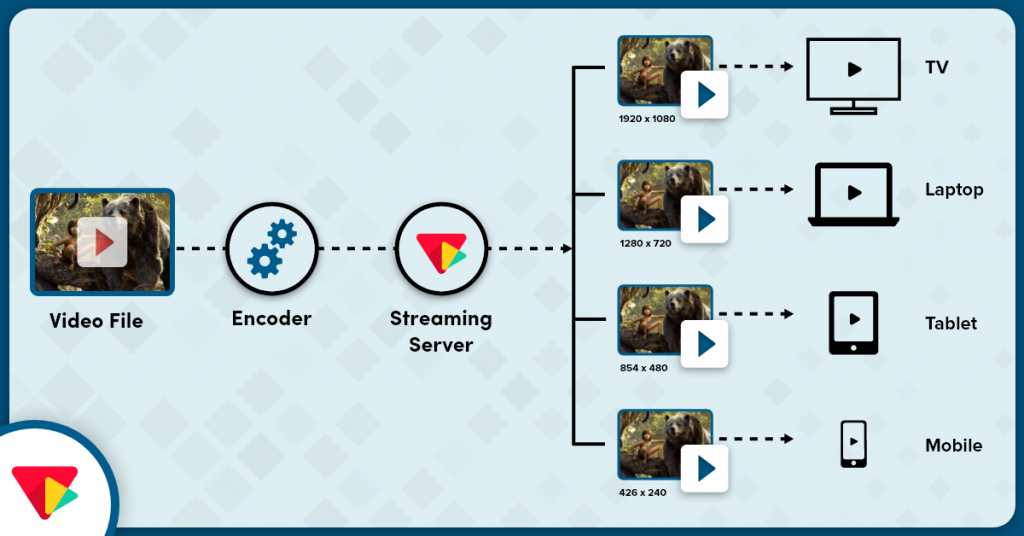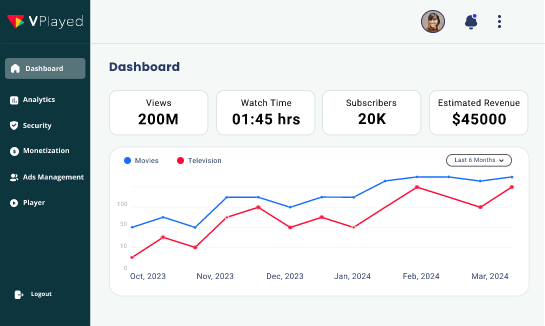How Adaptive Bitrate Streaming Optimized for User Experience?

In the past, you must have witnessed a case amongst consumers that sometimes they get a chance to encounter the scenario of watching your long-awaited movie or favourite show & then get disappointed.. The key reason behind this is the poor quality of the videos! After a while, the quality of videos starts to improve without your users having to do anything at all!!
There comes the power of adaptive bitrate streaming! Curious to know more about it?
Here in this article, we will be taking you through what does bitrate do for streaming and how it helps in delivering quality media videos.
Table of Contents
What’s all There to Learn About Adaptive Streaming?
The advanced technology of adaptive streaming ensures the greatest possible video quality & crystal viewing experience regardless of internet connectivity, devices or software. It’s a method generally used for dynamically altering compression level of streams & enhancing its streaming quality in order to meet its available bandwidth.
An interesting part to note here, is that some of the HTTP-based techies such as MPEG DASH, HLS, CMAF and WebRTC help to serve these renditions. Therefore, the adaptive HTTP streaming makes it possible to stream your videos both point to point as well as through multiple OTT platform devices.
Let’s consider an example:
Just imagine that you are running on a slow internet connection. Here the role of adaptive video streaming automatically switches from larger to smaller video file sizes & vice versa. This is done to keep the video playing neatly without any in between pauses & buffers. However, attimes the quality of video might have altered to avoid buffering, but will make sure to play without any sort of interruption.
Why Adaptive HTTP Streaming is Important?
The HTTP technologies-based adaptive bitrate streaming has a major role added with the suitable resolutions set across the entire video file. Its streaming technologies help the big video file to part it into smaller fragments that can be distributed independently.
Usually, with adaptive bitrate streaming player videos are stored on a server and compressed at various rates, ranging from 50, 100, 150, 2,500, 3,000, and 4,000 Kbps.
The assistance of ABR helps to convert a single video source into many versions with varying bitrates using the transcoder. This video streaming technique helps to detect the capacity of the device with the user’s bandwidth which automatically adjusts the quality of your streams.
This as a result you can make sure your interested viewers can enjoy watching the same stream inclusive of faster start time without any disturbance in a flexible internet speed network.
How HLS Adaptive Bitrate Actually Works?
Usually, adaptive bitrate video streaming is automatically done on the server-side, at the time of disseminating your renditions. The experts of video streaming create different video versions which are made compatible for each screen size. Along with this, it is made adaptable across several devices & at any connection speed. You can easily deliver high-quality videos along with outstanding bandwidth & performance.
Let’s delve deeper into its core functionality!
When we look into describing the streams some of the parameters include Bitrates, Subtitles, Resolution, Frame Rate and Codecs (in audio or video format). Denoting with all of these put together the specific stream will be played accordingly.
Here according to the chronological order or otherwise, the listed IDs are examined. When a video begins to play, the player has no knowledge of the network’s availability throughout. Here the HLS adaptive streaming downloads the first video quality to automatically make things easier. Looking into listing these files right from highest bitrate to lowest bitrate which is in reverse order it would send-in commands to stream highest video quality creating long delays in consequence to slower networks. Apparently, here streaming providers typically assist your streams by balancing the startup speed which in turn picks up in quality too.
Focussing on HLS files are now in video segments using adaptive bitrate video streaming. Further to that a programmed file which is known as the manifest initiates the process of segmentation to capture & download as per quality. After it’s done, it redirects to the player to play the video. Likewise, the process happens according to the file sizes and accordingly alters it with the streaming network for smooth playability.
Planning to start on how to do adaptive bitrate streaming?
When you start planning to have a customized online video platform, all kinds of technologies are deeply dug, to have best support for channelizing your VOD streaming cohesively. Some of the benefits that can help you is with segmentation, adaptivity & secured content distribution.
Segmentation – This is in turn a best resource as you can minimize overhead load of your video files which is segmented into smaller blocks, resulting in improved UX with high caching performance.
Adaptivity – When you get the power to deliver numerous channels in variable quality, the automatic switches according to device characteristics is a great aspect to leverage. This adds to the enhancement of the network performance too.
Secured Distribution – You can have major benefits of providing your streams worldwide without having any second thought on security. The efficient HTTP content distribution looks after your streaming pathways & maintains complete encryption.
Here are your best takeaways for developing your customized streaming platform!!
a.)Pick the Best Streaming Protocol
When you look into considering which kind of streaming protocol would be best for your online video streaming platform see to it that your potential videos have negligible or absolutely zero buffers. Scale your high-quality streaming experience with cost effective broadcasting technologies like adaptive bitrate video streaming, RTMP adaptive streaming protocol etc.
b.)Use a Variety of Bitrates
Generally, a higher bitrate used by the streaming experts will always yield better video quality. However there is seldom a chance of exceeding user bandwidths, as it can lead to disturbing buffers. Some of the variety formats that you can make use of are, MP$, MPEG-DASH, MOV. In codecs you can use H.264, whereas in color gamut you can have ranges from 8 to 4:2:2 ratio.
c.)Choose the Right Video Player
At the time of establishing your video streaming business, it’s quintessential to make a wise choice to select an apt video player which has best encoding capabilities inclusive of HTTP adaptive bitrate streaming framework. Besides that, the prior detection of net connectivity & its auto-processing capacity of bitrate streams in realtime is utmost necessary.
Conclusion
All in all, while we look into the bigger picture, the essential factor that carries high preference for broadcasters is with regards to user experience. In fact, many studies have been predicting that a user tends to abandon any kind of video stream that doesn’t carry any surprising element less than a half a minute. Indeed, this is the most integral aspect of your streaming business which would decide your upcoming playability profile when it concerns video streaming quality workflow.



Wow!! An excellent article. I want to update this technology (adaptive bitrate streaming) in my existing OTT app. It’s glad to consult with your tech experts. Let me know the solutions.
Nicely explained and the article covered each and every technology involved in adaptive bitrate streaming.
The most importat part of any video streaming platform to be succesful is its user experience and once it is done through adaptive bitrate streaming the viewers could see a better quality videos in their latfom
Too much of technical terms, so understanding these and explaination in this blog is very good and much more knowledge I gained through the article
The streaming technologies in video streaming platform plays a vital role as the videos need to b of same quality across all devices
The advanced technology of adaptive streaming guarantees the best possible video quality and this does helps a lot as users able to view the videos in different devices
When the most well-known streaming protocol, Real-time Messaging Protocol (RTMP) has been generally deprecated as a delivery method to end-users and the detailing is very well explained.
There are lot of information on this post with related to adaptive bitrate streaming and how the quality of video is maintained in various devices
The video bitrate of stream blog post cleared my views and it does help me to understand various technical terms and it also shows how speed for transferring video data to a user’s device.
while it is clear that Adaptive HTTP Streaming technologies are widely used and does provide the right solution and with this post I understand the adaptive HTTP streaming technologies
In this post I can see lot of technical information on adaptive bitrate streaming and got much more valuable information
The best bitrates to choose will depend on target audience, but it’s generally a good idea to offer multiple bitrates at varying levels of quality.
Real-time Messaging Protocol (RTMP) has been largely deprecated as a delivery method to end-users.
For broadcasters looking to offer adaptive bitrate streaming, a number of decisions need to be made around streaming protocols, bitrates, and video players.
Higher bitrate means the video quality will be better, but if it exceeds a user’s bandwidth that’s the reason why adaptive bitrate streaming is important
Adaptive bitrate streaming is a technology designed to deliver video to the user in the most efficient way possible and in the highest usable quality for each specific user. This article explains it very well
RTMP streams are encoded at a bitrate that was comfortably less than the bandwidth of target viewers.
Adaptive HTTP Streaming technologies enable distributing video efficiently via the standard HTTP infrastructure and CDNs
Having higher bitrate referring as the better quality of video and also the speed of transferring video data to a user’s device
The importance of using adaptive bitrate streaming are that you can deliver high quality streams to users with outstanding bandwidth and processing power and this article very well explains it
The Adaptive bitrate streaming is technology planned to send video to the user in most systematic way and also it provides the highest usable quality for each user.
Adaptive bitrate streaming provides the best video quality and viewer experience and this blog very well explains it.